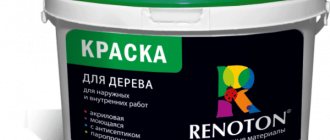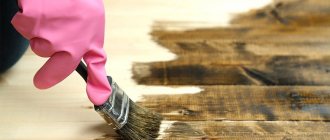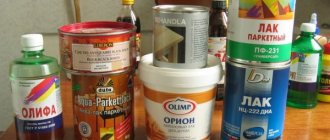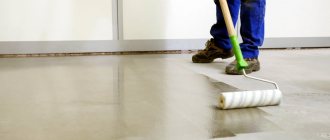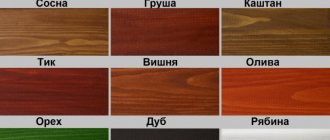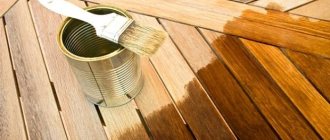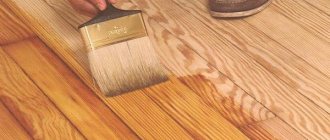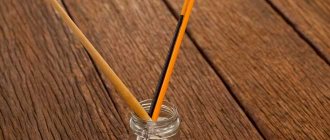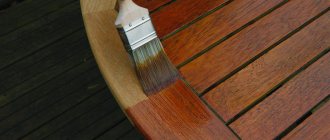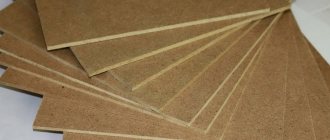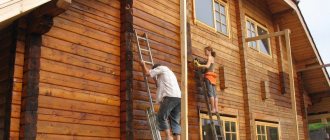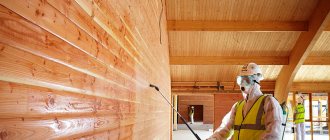Articles
All photos from the article
The main purpose of finishing wooden surfaces is both to give them an attractive appearance and to protect them from exposure to adverse factors. The greatest degree is provided by coating with varnish, which can be either colorless or colored.
The last option is a special building compound that can be used to treat the surfaces of any products made of wood, for example, doors, furniture, stairs, railings and even boats.
They use different colors of wood varnish in their work.
Colored wood varnish has the following main advantages:
- high degree of protection of surfaces from various adverse factors, both physical and natural;
- performing a decorative function that allows you to emphasize the natural beauty of the tree;
- easy to use, does not leave a pronounced odor and dries quickly;
- a combination of environmental friendliness of the material with the longevity of the products that are coated with it.
Black varnish for wood and its features
Types of wood varnishes
Manufacturers are ready to provide protective materials to suit every taste.
They can be:
- One and two-component. The first compositions are already completely ready for use (home craftsmen prefer them), the second ones will have to be mixed independently, focusing on the manufacturer’s instructions and one’s own preferences. But they are more durable and are often preferred by professional finishers.
- Matte and glossy.
- Transparent and tonal. The second option will allow you to make an imitation of a more expensive material from ordinary wood.
All these characteristics can be assessed immediately before purchasing, but it is better to find out the pros and cons of each type of varnish at the stage of planning the purchase.
How to update the coverage?
To make the process easy, you need to prepare. All work is described below in stages.
Tools and materials
You will need:
- wood varnish;
- bioprotective primer;
- brush, foam roller or spray;
- varnish tray;
- dry rags;
- solvent;
- wood putty;
- putty knife;
- sandpaper with fine and coarse grains;
- belt or vibrating sanding machine;
- construction hairdryer
It is necessary to purchase varnish with a reserve. Professional craftsmen apply the composition in two layers, paying special attention to the ends. It is recommended to provide an additional 10–15% reserve for painting damaged areas of interior doors or as a replacement for accidentally spilled varnish.
Preparatory work
The appearance of the updated door depends on the quality of its preparation. The sequence is as follows:
- Grinding. Use fine grit sandpaper (number 90–160). Perform the procedure carefully, carefully, treating every centimeter of the door. If you don’t want to waste time on such a tedious process, then the surface is treated with a grinding machine. It will speed up the work and allow you to get a better result.
- Cleaning. Vacuum the treated surface to remove any remaining dust.
- Putty. Inspect the door leaf in bright light. If cracks or damage are noticed, they must be puttied. The putty must have an identical shade to the base material. Otherwise it will be visible through the varnish layer. After drying, sand the putty areas.
- Primer. The bioprotective composition will repel insects and prevent the appearance of fungus and mold. It will fill the pores in the wood and reduce the consumption of the base varnish. After priming, sand the surface well with coarse grit paper (180 units).
Important
Construction materials and paints and varnishes must be made on the same basis. Otherwise, the components will react with each other, which will then lead to cracking and delamination of the door leaf. It is better to take products from one manufacturer.
Step-by-step instruction
- Stir the varnish in a production container. Do it slowly so that no air bubbles get into the jar. Carelessness will lead to unpleasant consequences: bubbles will be very difficult to remove, especially on the door leaf.
- Pour a small amount of varnish into the paint tray. Apply the composition to the doors using even, sweeping movements. Paint hard-to-reach areas with a brush.
- Avoid breaks or delays, otherwise transitions between layers will be visible.
- Apply the second layer so that it is perpendicular to the first. If a third layer is needed, its direction must coincide with the first. Wait for each layer to dry completely.
- Don't forget about the brushes. Paint the paneled part, frame, and trim with a narrow brush. If smudges appear, sand the surface with coarse-grit sandpaper (number 180).
While the varnish layer is drying, it is necessary to store brushes and rollers in a plastic bag. This will prevent them from drying out quickly and sticking together. If there are fittings on the doors, they are removed before varnishing. Otherwise, the impregnation will not reach hidden areas, which will lead to the appearance of rot or bark beetles.
If the door is made of veneer, then the varnishing procedure is carried out with extreme caution. It is forbidden to use a grinder - it will damage the top layer. The steps are performed manually or the work is entrusted to craftsmen. It is recommended to carefully select the paint composition.
- New doors do not need to be sanded. All you have to do is pick a varnish and get to work. If there is minor damage, varnish the surface and rub with Polish.
- The faux veneer door is suitable for painting. However, the varnish will roll down the canvas. Therefore, priming is needed.
Advice
It is better to take acrylic varnish. Apply in two layers. Too dense a paint structure will be lost after varnishing the door.
Features of varnishes
When choosing a future coating, pay special attention to:
- Conditions for future use. For items that are intensively exposed to ultraviolet radiation, rain, snow, wind, and temperature changes, practical and durable materials for outdoor use are selected. Its less durable brother will perfectly decorate furniture and interior decoration.
- Wear resistance. To decorate surfaces that are subject to severe abrasion (for example, floors), choose a varnish with the maximum level of wear resistance; for finishing decorative elements you can use the simplest varnish.
- Toxicity. Due to their structure, all varnishes have a strong aroma, but some materials stop emitting an odor quite quickly, while some are ready to smell for weeks, and the concentration of hazardous substances during application is very high for some materials. If it is not possible to arrange high-quality ventilation or close the room until the applied coating has completely dried, then it is better to use water-based products, but if it is possible to use protective agents and leave the wood to dry in splendid isolation, then you can use both hydrovarnishes and a polyester compound.
- Drying time. Water- and oil-based varnishes take the longest to dry, and therefore they are used if there is no urgent need to use varnished items in the coming days (weeks). Alcohol varnishes will acquire the necessary strength within half an hour.
- Temperature resistance. To decorate rooms where there is a high risk of fire and increased temperature, heat-resistant varnishes are purchased.
- The need for a primer. Self-priming varnishes do not require prior application of adhesives; all other materials are applied over a primer layer. Otherwise, the varnish may crack or begin to peel off.
Tips for choosing
The varnish for treating parquet is usually chosen by the client - on the advice of a parquet master who knows all the nuances
When restoring the floor yourself, it is important to do preliminary sanding and remove the old layer. It is incompatible with innovative new generation formulations
The intensity of the color may vary depending on the number of layers and the concentration of the color - it all depends on the preferences of the owners.
When choosing, it is important to consider the functionality of the room and the expected load. If the room will be rarely visited, walking in soft slippers on the bedroom floor, partially covered with carpet, heavy-duty film is not needed
It's better to be safe in the hallway. This includes outdoor shoes; abrasive particles will easily scratch the unstable coating.
You can give the parquet a pronounced gloss, which will act as a decorative element.In the dining room, kitchen or combined room, the parquet board should be impregnated with a primer and protected with waterproof LKS.
For non-residential premises in a large house (billiard room, wine cellar, dressing room, home cinema) a universal base is selected.
Varnishes used to treat the surface of parquet flooring for the purpose of protection are preferred by most consumers.
For a bar, small restaurant or cafe, where it is difficult to care for the parquet, it is preferable to treat the wood with wax mastic after careful sanding.
Types of varnishes for wood
There are about ten types of varnishes suitable for decorating wooden structures. They are divided according to the type of solvent, so they have completely different performance qualities.
Oil varnishes
These preparations are based on natural oils and resins. Despite such a pleasant neighborhood, this species is not very popular due to its high cost. Although now natural ingredients are increasingly being replaced by artificial compounds, which leads to lower prices.
Oil-based varnishes have proven themselves to be excellent when decorating floors, but you will have to wait 1-3 days for the surface to dry.
Mode of application
ZELEST VERESTA varnish is applied to a wood surface free of dirt, dust and coatings with a brush, roller, or sprayer in 1-2 (for wet or sunny conditions - 3) layers with intermediate drying for 45-60 minutes at normal humidity and air temperature not below +5 oC.
It is not recommended to paint in hot sunny weather to avoid reducing the absorbency of the composition due to premature drying. Do not apply to surfaces previously treated with drying oil! The color intensity and protective properties depend on the number of layers. Handle the ends especially carefully. The coating is produced in a ready-to-use form. Do not mix with other formulations. Stir before use. Under normal conditions, tack dry time is 1 hour. The final color is formed after complete drying!
Alkyd varnishes
To create these paints and varnishes, synthetic resins, solvents, and substances that increase the drying speed are used.
The advantages of this segment of coatings are:
- Resistance to all unpleasant living conditions (some of these varnishes can withstand even sunlight and are not afraid of fire);
- High wear resistance;
- Long shelf life;
- Loyal cost.
Similar paints and varnishes are used to decorate floors, including heated floors, and to decorate furniture sets and individual items.
You will have to wait for final drying for 2-3 days, and the varnish will emit a very unpleasant odor.
Color selection
Choosing a color scheme when tinting parquet is an important procedure, on which the style of your interior and its originality will depend. The standard oak color, made in yellow-brown tones, has already become boring to our compatriots
Therefore, more original shades, for example, smoky or stained oak, are becoming increasingly popular.
In addition, if you want to make your interior more modern and interesting, then you can choose a varnish in the color of bleached or blackened oak.
In addition, tinting allows you to make old floors more presentable. At the same time, the pattern and texture of the wood is completely preserved.
Optimal colors of tinted varnish:
- Dark, rich shades will give the floor an elegant and solid appearance. This coating goes best with warm, cozy tones. Most often, dark tinting is used in interiors designed in the Art Nouveau style. The most beautiful dark tones are dark chestnut, stained oak, chocolate shade and so on.
- White tinted paint material will allow you to emphasize your individuality. This kind of coating is at the peak of fashion today. Of course, a floor tinted white will not require particularly careful maintenance. On such a coating, dust will be almost invisible, unlike a subfloor. White tinted parquet will make your interior lighter and weightless.
- The brown tinted floor symbolizes comfort and reliability. This is a very versatile color as it suits almost any interior style. Brown varnish goes well with all shades of furniture, from yellow to dark tones.
- Gray tinted paint and varnish material will help make the parquet more elegant and solid. This color goes well with white and black interior elements. In addition, a floor covered with gray varnish will look good with cool and autumn tones.
- Dark red and cherry tinting will add coziness and warmth to your interior. At the same time, it will be more difficult to choose the optimal combination with other interior elements for this floor color. For example, such a floor goes perfectly with yellow, brown and green interior elements. At the same time, red tinted paint and varnish composition does not combine with cold tones.
Thus, tinting paint and varnish material will make parquet or any other wood covering more presentable and stylish. In addition, applying tinted varnish will make the coating more wear-resistant and durable.
Alkyd-urea varnishes
The two-component material hardens using special hardeners. But this composition will be good for only a few hours, so it’s quite difficult to guess the size of each portion.
The varnish perfectly protects objects from water and is able to withstand high loads.
It is usually used to design:
- Sexes;
- Wall panels;
- Furniture;
- Decorative elements located indoors.
Nitrocellulose varnishes
The paintwork materials of this group include:
- Artificial resin;
- Plasticizer;
- Organic solvent;
- Cellulose nitrate.
Varnish is popular for finishing interior surfaces due to:
- Quick drying;
- Possibility of further polishing;
- High decorative properties;
- Deep penetration into the layers of wood.
Among the disadvantages, the following stand out:
- The need for protective equipment;
- Strong smell.
Polyurethane varnishes
These varnishes have maximum durability and are therefore considered a universal finish.
The advantages of this group were:
- Excellent performance properties;
- Easy penetration into layers of wood;
- High drying speed.
The varnish is great for decorating exterior surfaces and interior decoration.
The disadvantages of these varnishes are the price and the need to strictly follow the manufacturer's instructions.
Water-based acrylic varnishes
This category of varnishes is considered to be the most environmentally friendly paints and varnishes. The material does not emit odors and is completely safe, therefore it is used even when decorating children's rooms.
The disadvantage of varnish is that it takes a long time for surfaces to dry:
- The varnish will finally harden a couple of weeks after application.
- In addition, it is not very suitable for outdoor use, not providing the required level of moisture resistance.
- And in terms of abrasion resistance, the varnish has not proven itself very well.
Scope of use
Based on the European Regulation C 2354 “Transparent coatings for wooden floors and varnishes made from them, minimum requirements and tests” of March 1, 2009, there are three categories.
| Category | Description |
| A | Intermittent use of the surface, infrequent loads of walking in shoes (rooms for receiving guests, kitchens, bedrooms). According to the wear resistance classification for laminated and linoleum coatings, it is similar to classes 23 and 31. |
| IN | Constant use of the surface, walking in shoes (lobby, corridors, school premises, universities, office rooms). Compliance with 32-33 wear resistance classes. |
| WITH | Increased exploitation (places with a large flow of people, supermarkets, hospitals, cafes). According to the wear resistance classification for laminated and linoleum coatings, it is similar to classes 33, 41-43. |
Regulatory document C 2354 does not contain information about the maximum possible level of impact from furniture wheels (tables, chairs). This is due to the fact that the ability to withstand the load of the rollers is directly dependent on the species and grade of the wood material.
There are several types of parquet depending on the type of use
When operating sports facilities and halls for physical activity, it is usually necessary to use varnish coatings that maximally protect the flooring from wear.
For example, the Petri series has an alkyd-based varnish composition with SPAR GYM technology, which is non-slip; in addition, it is able to protect the coating during intensive use, and does not interact with water during wet cleaning.
Which class of parquet is better to choose?
Epoxy varnishes
These materials were developed based on epoxy resins and differ:
- High strength;
- Hardness;
- Wear resistance to abrasion and mechanical damage.
The material will be an excellent option for finishing interior spaces, including floors; it also serves well for exterior decoration.
Treatment of external walls
If you need to protect an outdoor wooden, concrete or brick wall, then you should not choose a water-based aqualac, for example, an acrylic composition, because it will not last long. For outdoor surfaces, it is better to use varnish solutions based on organic solvents.
One popular option is alkyd varnish composition. It has a high level of moisture resistance and weather resistance, but its disadvantage is its long drying time. But if the alkyd solution is mixed with a special hardener, the drying period will be significantly shortened.
In addition to alkyd, other types of varnishes are used, which create a durable protective layer that is resistant to harmful external influences. They are resistant to temperature changes and ultraviolet rays, are easy to apply, have almost no color, and make the surface visually attractive. Among such compositions based on organic solvents are:
- urethane;
- nitro varnishes;
- oil;
- bitumen;
- epoxy;
- shellacs.
Each of these varieties has its own properties and technical characteristics; coating walls with organic solvent-based varnish is used mainly for treating external surfaces of brick, plastic, concrete, foam concrete and wood.
Polyester varnishes
The varnish will be an excellent coating for finishing floors, furniture and even musical instruments.
But working with this material is quite difficult: It requires special equipment and professional skills.
Water-based polyurethane varnishes
Such materials have become an improved copy of acrylic varnish.
They are characterized by:
- Resilience;
- Elasticity;
- Durability;
- Environmentally friendly;
- Durability.
The only downside will be the high price of the material.
Alcohol varnishes
Such coatings are made on the basis of ethyl alcohol. Thanks to the rapid evaporation of the volatile substance, the varnish dries almost instantly: the maximum period is only an hour.
The advantage of this material is its light shine, the disadvantage is poor resistance to water and damage. Most often, such varnishes are used for the final finishing of musical instruments and furniture structures.
A variety of varnishing materials will help create a durable and beautiful coating that will suit all the needs of future owners.
Color spectrum
The main task of a paint coating is to create a durable coating and give it a color effect.
Using colored varnish has several advantages:
- protection from external factors;
- decorative function;
- the service life of the material increases.
Homeowners often purchase glossy varnish for their interiors - this applies to rooms that are quite dark. The clear look is one of the few examples where the natural structure of wood is emphasized through the application of varnish.
For example, by covering a parquet board with walnut-colored paints and varnishes, you can get several different color effects. It can be beige, red, black or dark brown.
Home owners also like to use tinting compounds. They cover doors, furniture, and parquet. The wood gains an unsurpassed appearance, as well as resistance to mechanical stress. Blue stains, fungus and mold will not form on this surface.
